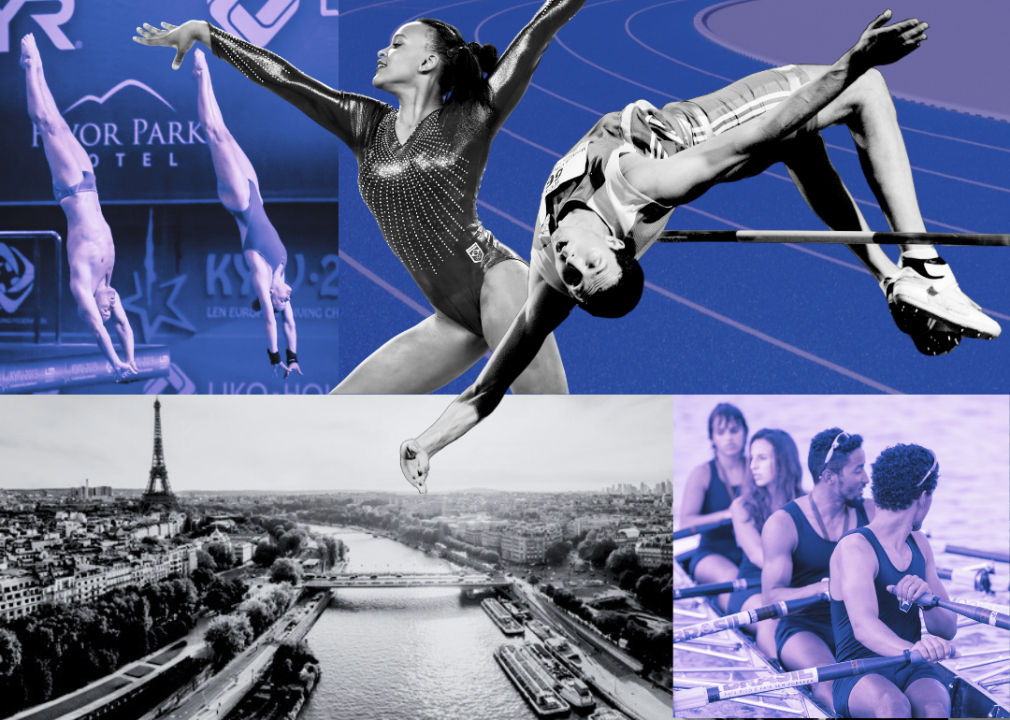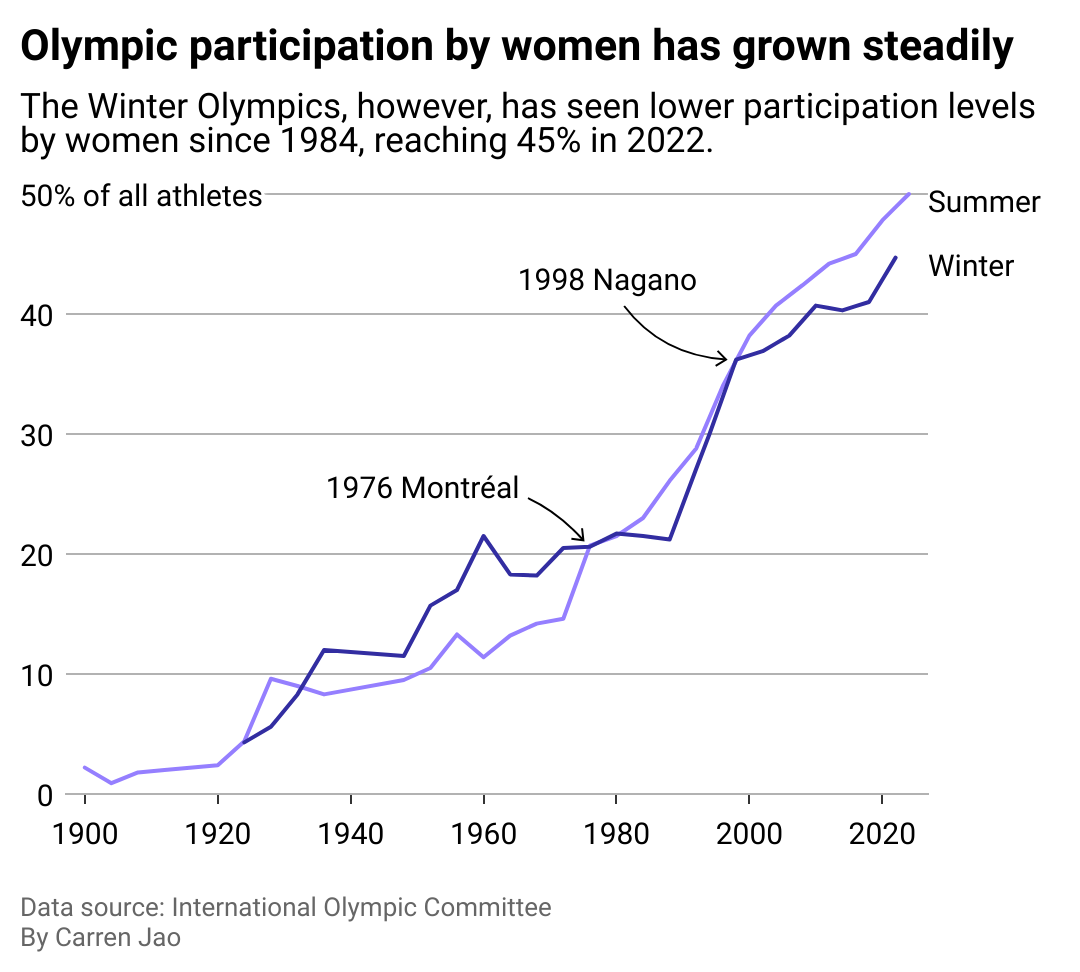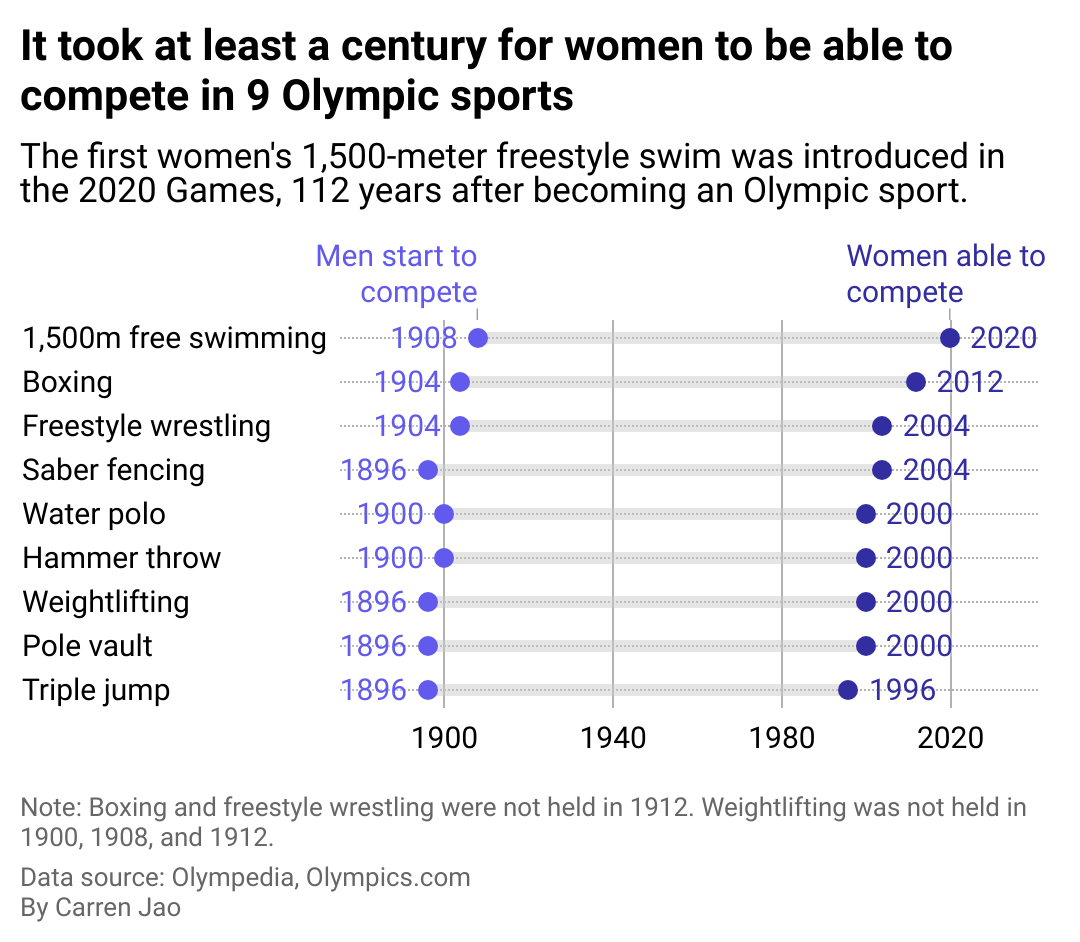In Paris, the Olympics will achieve gender parity, but it's still too soon to celebrate

Photo Illustration by Stacker // Shutterstock
In Paris, the Olympics will achieve gender parity, but it’s still too soon to celebrate
A collage of images of Olypmic athletes competing.
A pinnacle of athletic competition, the Olympics has long been held to a higher standard, especially when it comes to the basic tenets of any sport: fairness. An everyday word taught even to kindergartners, “fair,” however, is a mercurial standard, subject to changing social mores and ideas on gender and race.
“There was a point where fairness meant not including women at all,” Katrina Karkazis, cultural anthropologist and co-author of “Testosterone: An Unauthorized Biography,” told Vox. “There was a point where fairness meant don’t include people with disabilities, don’t include Black people.”
In pinning down what “fairness” could mean, most look to gender—the number of male and female athletes—as a basic metric, just as the International Olympic Committee did when it declared a “monumental achievement” this past March. For the first time in history, the Olympics will have an equal number of men and women competing at Paris 2024, it hailed. While this is indeed a major step forward, gender parity isn’t the only measure of gender equality.
Stacker scoured Olympic records and news articles and interviewed experts to trace how gender has affected the Olympics and what “gender parity” means for the Games.
It’s important to note that the IOC tracks gender parity in a binary way, limiting itself mostly to cisgender men and women. Though the IOC has created a framework for inclusion when it comes to gender identity and sex variations, it has left it up to each sporting body to set its own policies. As a result, at least 10 Olympic sports have restricted participation for trans athletes at the 2024 Paris Games. Some have barred trans athletes outright, while others gauge a player’s eligibility by what age they transitioned or the athlete’s testosterone levels.
In Paris, around 10,500 athletes will compete to become Olympic champions. The participation of women in Paris will be an improvement from the Tokyo Games, which achieved what the IOC called “gender balance” with nearly 49% of competing athletes being women.
This focus on participation numbers, however, sidesteps the fact that the Olympics still has several disparities to contend with, such as different events or distances for men and women athletes—outcomes shaped by ideas of what is supposedly feminine and the perceived physical limitations of women.
In athletics (aka track and field), men have a 110-meter hurdle race, while the women’s hurdle sprint is just 100 meters. Men also compete in the decathlon, a 10-event race, while the women have a heptathlon, a seven-event competition. Artistic swimming (a sport many mistakenly think of as women-only) will allow men to compete for the first time at the Olympics—but only in the team event. The duet will still be a women-only competition.
The IOC’s history of exclusion from the Olympic Games could arguably go as far back as its first ancient Greek iteration in Olympia, which banned women’s participation, but a more direct tie lies with founder and second president Pierre de Coubertin. His attitude toward women directly affected their ability to compete in the Games.
![]()

Carren Jao // Stacker
How women’s participation in the Olympics has changed over time
Line chart showing Olympic participation by women since 1900. It shows that Summer Olympics in 2024 reached 50% participation rate and that the Winter Olympics has seen lower participation levels since 1984, reaching 45% in 2022.
“Well, considering that the modern revival in Athens 1896 made no provision for women to compete, we can certainly see Paris as evidence of improvement—it just took 128 years to get here,” Bonnie Hagerman, assistant professor at the University of Virginia and author of “Skimpy Coverage: Sports Illustrated and the Shaping of the Female Athlete,” told Stacker.
Hagerman noted that for many years, “women’s Olympic participation was an afterthought.” Pierre de Coubertin preferred that women be relegated to handing out awards, and subscribed to a popular opinion of the time that sports were detrimental to women’s reproductive health.
Although women didn’t take part in those first Olympics, they did compete in subsequent Games, due in part to the fact that host cities chose the sports and events, but their participation was minimal. “Once the IOC took control of the docket, women’s events were limited,” Hagerman explained.
“Perhaps most contentious was the battle over adding track and field events for women,” Hagerman said. It was only after pressure from a competing event—the Women’s World Games, which ran from 1922 to 1934—that the IOC decided to add five women’s events to the 1928 Olympic program, the 800-meter run being one of them. Many IOC members and male sportswriters believed this was too long of a distance for women, and the press fabricated the details of the race, playing to sensationalized notions of women’s frailty.
“Below us on the cinder path were 11 wretched women, five of whom dropped out before the finish, while five collapsed after reaching the tape,” John Tunis wrote for the New York Evening Post. Other papers fanned fears that such long distances would impair a woman’s reproductive abilities. These reports caused the IOC to drop the event and not allow women to run longer than 200 meters, a decision that effectively shut women out of the sport for more than 30 years.
While women’s participation slowly increased throughout the 1960s, it spiked at the 1976 Montréal Olympics due to the addition of basketball, rowing, and handball. These team sports increased women’s participation to just over 20% of the athlete count, up from 14.6% at the 1972 Munich Games, the largest percentage-point jump in women’s participation.
The 1996 Olympics in Atlanta was another watershed moment. The inclusion of women’s softball and soccer gave the Summer Games an additional 5 percentage points from 1992. Women now made up 34% of all athletes. “In 1996, there was a lot of discussion about that being sort of the year of the woman, at least for U.S. Olympians,” Cheryl Cooky, associate professor at Purdue University and co-author of the book “Serving Equality: Feminism, Media, and Women’s Sports,” told Stacker.
That’s not to say organizers were convinced women would draw crowds. In the women’s soccer tournament, group-stage matches were played as doubleheaders with men’s games to ensure attendance. They shouldn’t have worried—women drew big crowds, and the gold medal match between the U.S. and China still ranks as one of the highest-attended women’s soccer matches of all time with 76,481 fans.
“2012, again, that was framed as the year of the woman,” said Cooky. Women’s participation had climbed to 44.2%, and a Play the Game audit noted that this was the first Summer Olympics with both men and women in every sport. Furthermore, all countries allowed women to compete, a first for parts of the world where women struggle for even the right to play.
“I think it’s more interesting how the narrative of gender progress gets retold or gets told repeatedly across history and what that retelling of that same narrative signifies,” said Cooky. “The IOC, or at least the Olympics itself, is really touting itself as this space of gender progress, progress toward equality, progress toward inclusion, and it’s finding sort of different ways to tell that same story without really addressing what I would see as the significant issues.”
The Winter Olympics still trails the Summer Games in terms of parity, even though women had a higher participation rate in early editions of the Games, in part due to the smaller number of sports in the program. In 1936, participation rose nearly 4 percentage points when Alpine skiing was added to the Games for both men and women, which gave women opportunities to compete in two of the eight sports on the program. Women’s participation also rose 4.5 percentage points in the 1960 Squaw Valley Games, when they were allowed to compete in speed skating, and jumped a hefty 6.2 percentage points from the previous Winter Games to 36.2% in 1998, when women’s ice hockey was added.
Winter athletes still face a lack of equality, though. Nordic combined is the one sport—summer or winter—that doesn’t have a women’s event at the Olympics. Women also face smaller quota numbers in sports like bobsledding, where women compete in monobob and two-women events, while men have historically competed in two-men and four-person sleds.
“There is a longer history of women being excluded than included. So the fact that we’ve made it to this point I do think it is worth celebrating, although I’m not going to throw the huge party just yet because there’s still work to be done,” Lindsay Parks Pieper, associate professor of sport management at the University of Lynchburg, told Stacker.

Carren Jao // Stacker
What does it mean for men and women to compete fairly?
A range plot showing the nine Olympic sports that took at least a century to allow women to compete: 1500 meter free swimming, boxing, freestyle wrestling, saber fencing, water polo, hammer throw, weightlifting, pole vault, and triple jump.
Since 1991, any sport seeking inclusion in the Olympic program must have both men’s and women’s events. That rule didn’t apply to sports that were already on the program. Many female athletes competing in those grandfathered sports had to wait a long time to have their moment on the Olympic stage.
One of the original modern Olympic sports, wrestling was one of the last to add a women’s component, doing so when the Olympics made its first return to Athens, the city where it all started. Women’s freestyle wrestling was the only new sport at Athens 2004, which introduced four weight classes, while men had seven weight classes.
In 2013, the sport of wrestling was in turmoil, and the IOC threatened to drop it from the Olympic program. One change that saved the sport’s place was the addition of more women’s weight classes. Women now have the same number of weight classes as men’s wrestling events, a feat achieved in 2016. However, there’s still one big disparity in the sport: Women still do not compete in Greco-Roman wrestling.
Water polo was one of the first team sports in the Olympics, with a men’s event held at the Paris Games in 1900. It also has the distinction of being the last team sport to have a women’s event, which it debuted 100 years later. Australian women advocated for Olympic inclusion for 20 years and were rejected three times. When Sydney won the right to host the 2000 Games in 1993, the fight continued for four more years until it was officially added to the program in 1997.
Boxing was the last sport on the Summer Olympic program to add a women’s event, although it was a “display event” (nonmedal) at the 1904 St. Louis Olympics. Women were banned from competing in the U.S. until 1993 and in Great Britain until 1996 due to stereotypes about the sport making women masculine. Some male leaders in the sport also thought premenstrual syndrome prevented women from being able to box well.
The way officials added boxing to the 2012 London Games shows one contentious way the Olympics has made space for women: by taking away men’s events. Although the IOC wanted to add a women’s component, it didn’t want to increase the overall number of athletes in the sport. The solution was to approve three women’s weight classes, but reduce the number of men’s weight classes from 11 to 10. At the Paris Games, men will fight in seven weight classes, and women will compete in six.
Another way officials have sought parity is to create mixed-gender events. While equestrian athletes have had mixed-gender events for years, the 2020 Tokyo Games saw the debut of swimming, triathlon, and athletics mixed relays, as well as shooting, judo, and table tennis mixed-gender events. In Paris, the men’s 50-kilometer racewalk will sunset to make room for a mixed-gender racewalk relay.
Although gender parity in competitive events is paving the way for potential gender equality at the Olympics, the Games and the IOC still have a long way to go, in terms of true equality, especially at leadership levels, points out both Pieper and Cooky. Women only make up 41.1% of IOC membership and under 27% of leadership in sports international federations—the governing bodies for each of the different Olympic sports. Even at coaching levels, women’s representation is dismal. At the 2020 Tokyo Games, women accounted for only 13% of coaches.
There are a myriad of ways to think about what is fair, according to these experts. One aspect to look into is the level of funding support between men’s and women’s sports, said Pieper. Another is seriously considering how to move beyond a gender binary, said Hagerman.
The larger question is not about equality, but equity, said Cooky. Rather than everyone getting the same amount of something, it is more about recognizing that people have varying circumstances and access to opportunities, and then providing resources so they can achieve an equal outcome—an Olympian task indeed.
Additional data work by Jill Jaracz. Story editing by Carren Jao. Copy editing by Tim Bruns.